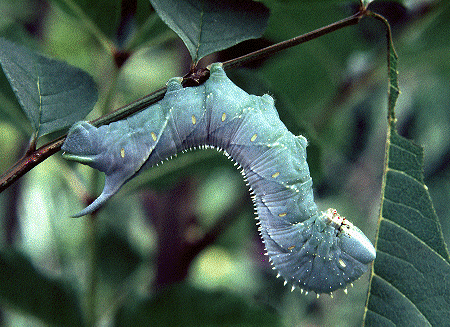Type locality: Kansas City, Missouri, USA.
Wingspan: 100--128mm. Outer margins of the forewings slightly concave in the male, but not the female. Costal half of the forewings grey, but the posterior portion a distinctive warm yellowish-brown; the boundary between these two areas is marked with a series of dark diagonal streaks. The hindwings are black with brown basal patch, median band and margin.
A species of lowland deciduous woodland which is attracted to light.
Univoltine in the north, with adults mainly in late June and early July. Farther south there may be a partial second brood in August-September.
OVUM: Glossy pale yellow, ovoid, 1.90 x 1.70mm, with the young larva becoming visible through the shell.
LARVA: Full-fed 85--92mm.

On hatching, the pale yellow larva measures approximately 5-6mm and bears a large, black-tipped, orange-red horn. With feeding the basic body coloration becomes greenish and later in the instar a pale, double, dorso-lateral line appears, stretching from the horn to the head. There is also a subspiracular line of the same colour on the anterior segments. During this stage it rests stretched out along the midrib on the underside of a leaf and eats very little.
After the first moult the body becomes glaucous green and very shagreened. The dorsal surface is paler, almost white. The upper of the double, dorso-lateral lines becomes dominant and very white, with seven oblique white stripes developing laterally. A ventro-lateral line of the same colour appears on the thoracic segments. The head is pale green, triangular, notched and spiny at the vertex, with yellow cheek stripes, and the horn is orange with paler, almost yellow, edging. In behaviour it continues to be very lethargic.
In the third instar the basic body colour becomes bluish-grey, tending to whitish dorsally. The oblique lateral stripes become creamy, that at the base of the horn being more prominent. The head is apple-green with yellow cheek stripes, the horn pale buff-yellow with a tint of orange dorsally. The latter also bears fine, purple tubercles. The upper of the pair of dorso-lateral lines is now very prominent, creamy-white, and bears closely-packed, tooth-like tubercles in the form of a ridge. The true legs are green with pink tips.
The fourth instar is very similar to the third, but with clear sea-green shading/edging down the front of each oblige lateral stripe. The horn is robust, straight, pale cream laterally, bluish-grey above and below, and blends with the prominent last oblique lateral stripe. In fact, all lateral stripes bar the last stripe become very faint, with the lower half of each being more yellow than white, and often consisting of no more than a row of large tubercles. The 'teeth' on the upper dorso-lateral line are now separated, giving the impression of a pair of parallel toothed crest down the larval back, with those towards the head being yellower and larger. The head and thoracic segments are flushed with apple-green, with the heavily armoured anal flap being edged with yellow. The larva now likes to hang from the petiole beneath a leaf. Strangely, after a few days of feeding the larva will often sever most of the upper leaf by chewing through the petiole.
The final instar is very much like the fourth. The sea-green head is now broadly triangular with pale yellow cheek stripes. The thoracic segments are compressed laterally and the spiracles are orange. The very stout horn is slightly curved, blue-grey above, greyish below, and creamy laterally. Dorsally, the abdominal segments are almost totally white apart from sea-green lines bordering the toothed crests and, occasionally, a lilac blush. The basel segment of each true leg is green with a yellow top, the central segment is red and the tip pinkish.
Hostplants. Strictly various species of ash (Fraxinus). Reports of this species on elm (Ulmus) are erroneous and are probably due to confusion with Ceratomia amyntor (Geyer, [1835]).
PUPA: 50--56mm. Dark blackish-brown, but intersegmental cuticle of mobile segments dark mahogany-brown. Tongue-case very short (<5mm), free, but lying flat along the ventral surface. Cremaster robust, cylindrical, with a single terminal spine. The overwintering stage.
None recorded.
A species of the eastern USA, ranging from New York State to northern Florida, and eastwards to Missouri and Louisiana.
Extra-limital range. None.
None.
Covell, C. V. (1984). A field guide to the moths of eastern North America. Boston, USA: Houghton Mifflin Company.
Hodges, R. W. (1971). Sphingoidea, Hawkmoths. In: Dominick, R. B. et al. [Eds]. The moths of America north of Mexico (including Greenland) 21. London, UK: E. W. Classey.
Holland, W. J. (1968). The Moth Book (2nd edn). New York, USA: Dover Publications Inc.
 Return to Hawkmoths of the western Palaearctic.
Return to Hawkmoths of the western Palaearctic.